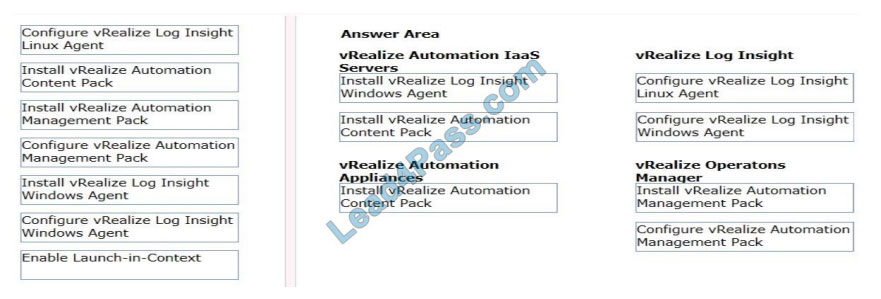The latest updated VMware Advanced Level 3V0-732 exam certification tips

The latest update of VMware Advanced Level 3V0-732 exam dumps. This is a temporary update.
If you want to get more free VMware exam series, please visit itexamcourses.com.
This site shares 3V0-732 exam dumps https://www.leads4pass.com/3v0-732.html (PDF+VCE). Continue to study,
below I will share free VMware 3v0-732 exam practice questions from the Lead4Pass 3V0-732 exam dumps part.
And VMware Advanced Level exam series dumps.
More official learning:https://mylearn.vmware.com/mgrReg/courses.cfm?ui=www_edu&a=one&id_subject=88985
VMware Certification official channel:https://www.vmware.com/education-services/certification.html
VMware 3v0-732 exam practice questions
The test answer is at the end of the article
QUESTION 1
An architect has been tasked with expanding the design of an existing production instance of vRealize Automation
(vRA) to integrate the assets of a newly acquired company. This acquisition has the following new resources:
1. A vCenter Server
2. An A WS presence
3. A HyperV Server
Which design recommendation should the architect make in order to integrate these new resources into the current vRA
distributed deployment?
A. In the vRA Virtual Appliance Management Interface (VAMI)1 select the Cluster page on the vRA Settings tab and add
the three new nodes to your vRA cluster architecture.
B. Integrate new VSphere and Hyper-V proxy agents into the distributed IaaS server architecture. Design three new
endpoints for vCenter, Hyper-V, and Amazon EC2 within the vRA UI based on the configuration specifications of each.
C. By leveraging the existing environment\’s proxy agents, design three new endpoints for vCenter, Hyper-V and
Amazon EC2 with hin the vRA UI based on the configuration specifications of each.
D. Integrate three separate new proxy agents for each new resource into the distributed IaaS server architecture.
Design the respective three new endpoints within the vRA UI based on the configuration specifications of each.
QUESTION 2
A cloud architect is tasked with designing a vSphere-based private cloud multi-machine blueprint solution for an
organization\’s complex application consisting of multiple virtual machines (VMs) and a container. During requirements
gathering, the following requirements are identified:
1. The application, which runs in a container, should be able to access the internet and update an existing internal
database.
2. Provisioned VMs should NOT have access to the internet or external database.
3. A third-party Configuration Management (CM) tool should be used for multi-machine automation.
4. Before integration with the CM tool container, the application should start and update the existing internal database.
5. Any information received from the container VM should be available before the CM toll agent is installed.
Which is the best CM tool integration design recommendation for this scenario?
A. vRealize Automation external custom properties and CloudClient
B. vRealize Automation blueprint with software components
C. Virtual Machine template with pre-installed CM agent
D. vRealize Orchestrator workflow at POST Machine Provisioned Event Broker state
QUESTION 3
The tenant administrator for a company\’s vRealize Automation deployment is asked to create a profile for a user that
should be able to assemble the blueprints that define catalog items for consumers to request from the service catalog.
Which tenant role should this user be granted?
A. Fabric administrator
B. Catalog architect
C. Blueprint administrator
D. Application architect
QUESTION 4
During requirements gathering for an organization\’s private cloud on a single machine catalog, the following
requirements were identified:
A user should be able to select a data center location that is mapped to a custom resource by the fabric
administrator.
A Guest VM custom hostname format should be based on the first two letters of the data center location.
A generated VM custom hostname format should be displayed as a drop-down in the catalog request page using a
vRealize Automation (vRA) custom property backed by external vRealize Orchestrator (vRO) action.
Which design recommendation would best address these requirements?
A. Define a custom property “_vrm.DataCenter.Location” with static datacenter values, assign it to the blueprint with the
“Show in the request” check box selected and map it as an input to the required vRO action.
B. Define a custom property “Vrm.DataCenter.Location” with static datacenter values, assign it to the blueprint with the
“Show in the request” check box selected and map it as an input to the required vRO action.
C. Enable “Display location on request” in the blueprint\’s VM machine type, map the built-in “Vrm.DataCenter.Location”
custom property as an input to the required vRO action.
D. No new custom property is required since the fabric administrator has already mapped data center locations to the
correct compute resources. Map the built-in “_vrm.DataCenter.Location” custom property as an input to the required
vRO action.
Reference: https://docs.vmware.com/en/vRealizeAutomation/7.5/com.vmware.vrA.prepare.use.doc/GUIDFA2ED665-4973-435C-A93B-8E4EAB5D1F8A.html
QUESTION 5
The architect for a teaching hospital is planning the deployment of a highly distributed cloud management platform
based on VMware vRealize Automation. The design must ensure that all virtual machines should be set up in a
prescribed order.
vSphere 6.5 will be used as the deployment platform.
vSphere Availability VM Groups and VM Rules will be used.
The design will use a vRealize Orchestrator embedded in the vRealize Automation Appliances.
Place the virtual machine groups in the correct start-up order.
Select and Place:

Correct Answer:

QUESTION 6
The lead architect for a teaching hospital in Seattle is planning the deployment of a highly distributed Cloud
Management Platform based on VMware vRealize Automation. The design must include log aggregation and analytics
for in-depth troubleshooting and analysis when issues arise and ensure a seamless experience for the operations teams.
The organization must use vRealize Log Insight for log aggregation and analysis.
The organization currently uses vRealize Operations for monitoring, alerting, and capacity management.
The design will use external vRealize Orchestrator Appliances.
Match the actions to the components. Some of the components may be associated with more than one action.
Select and Place:

Correct Answer:

QUESTION 7
An enterprise-class software company merged with an enterprise-class storage provider. Both had operational vRealize
Automation environments prior to the merger. The architect has recommended a combined private cloud (vRealize
Automation) environment.
The following requirements have been set:
?There should be separate email servers for notification. ?Blueprints should NOT be visible across organizations.
?Property group(s) should be unique to each organization. ?Machine prefixes should be unique to each organization
with duplicate machine names. What should the architect recommend to meet these requirements?
A. Separate tenant for each organization.
B. Separate business group for each organization.
C. Custom group for each organization as tenant administrator within the default tenant.
D. Separate fabric group for each organization.
QUESTION 8
The Human Resources (HR) team would like its members to be able to manage and delete Active Directory user
accounts in vRealize Automation while protecting against accidental user account deletion.
In which two ways could this be accomplished? (Choose two.)
A. Create an Approval Policy for \’ Service Catalog – Catalog Item Request\’ requiring that HR managers authorize the
deletion action.
B. Create an Approval Policy for \’ Service Catalog – Resource Action Request\’ requiring that HR managers authorize
the deletion action.
C. Create an Event Broker subscription to notify HR managers and prevent the deletion from occurring.
D. Create an Event Broker subscription to notify HR managers and move the account into an archive OU.
QUESTION 9
Which two-factor authentication mechanism is supported by vRealize Automation?
A. Mobile SSO (Secure Sign-On) authentication
B. AirWatch Cloud Connector authentication
C. Certificate-based authentication
D. RADIUS (Remote Authentication Dial-In User Service) authentication
QUESTION 10
An architect has been asked to design a machine blueprint for the development team. The machine(s) of each
the deployment must contain dynamically assigned unique IP\’s that could be reached by the resources on the corporate
network.
Which type of network should the architect recommend for this blueprint?
A. On-Demand NAT Network
B. Existing Network
C. On-Demand Routed Network
D. On-Demand Load Balancer
QUESTION 11
When assigning fabric administrator role to a user or group of users who will manage the implemented fabric group
design of the vRealize Automation deployment, which are three considerations to take into account? (Choose three.)
A. The architect can add the fabric administrator role to a system-wide role such as IaaS administrator or system
administrator so that the fabric administrator can create reservations for any tenant, NOT just their own.
B. The fabric administrator manages physical machines and compute resources assigned to their fabric group(s) and
creates and manages the reservations and policies associated with those 1sources within the scope of their tenant.
C. The fabric administrator is responsible for user and group management, notifications, and business policies such as
approvals and entitlements.
D. The fabric administrator manages property groups, n1achine prefixes, and the property dictionary that are used
across all tenants and business groups.
E. The fabric administrator tracks resource usage by all users within the fabric group and initiates reclamation requests
for virtual machines.
QUESTION 12
A company has recently implemented a DevOps strategy amongst the development and operations teams. In the
second phase of the project, it needs to apply the same best practices of version control, unit testing, and continuous
delivery to its vSphere infrastructure. Considering the scenario, which two statements are true regarding the solution?
(Choose two.)
A. Content changes for the infrastructure generally flow from development to multiple test and production environments
and are often developed separately by different team members and then merged into a shared environment.
B. Infrastructure content is usually binary, and this makes it difficult to use a source control system to handle updates
and merges. A different tool must be used to manage these requirements.
C. Multiple steps of imports and exports of infrastructure contents are required for a single change to propagate through
the release pipeline from development to production.
D. Once the movement of such content between environments is automated, consistent results are guaranteed for the
deployment of infrastructure components.
Reference: https://www.vmware.com/files/pdf/products/vrealize/vmware-vrealize-code-stream-managementsolutionbrief.pdf
QUESTION 13
The security team has mandated that all new virtual machines undergo an automated network security scan when
provisioned. The security team has provided the cloud architect with the REST API calls necessary to interface with the
security scanning solution.
Which design recommendation would enable this capability?
A. Create an Orchestrator workflow to trigger the security scan based on a subscription to the BuildComplete lifecycle
state.
B. Design an approval policy that references the external REST API and associates this approval policy with the IaaS
machine provisioning workflow.
C. Design a software component that includes the REST API calls during the Install script, and include
D. This component on all systems.
E. Create an Orchestrator workflow to trigger the security scan based on a subscription to the MachineActivated
lifecycle state.
Publish the answer:
| Q1 | Q2 | Q3 | Q4 | Q5 | Q6 | Q7 | Q8 | Q9 | Q10 | Q11 | Q12 | Q13 |
| B | D | D | C | image | image | A | AB | D | A | ABD | AC | E |
VMware 3V0-732 exam PDF
In order to facilitate your study habits, we also shared VMware 3v0-732 PDF: https://drive.google.com/file/d/1Kvp-Z0MK9AuveFKXG8aTwMFGeY8hBwEz/
VMware Advanced Level exam series
We share free VMware exam practice questions throughout the year. All exam practice questions come from a part of the Lead4Pass VMware exam dumps.
The free VMware 3V0-732 exam practice questions can only let you understand part of the exam and get the
complete VMware 3V0-732 exam Dumps https://www.leads4pass.com/3v0-732.html (Total Questions: 90 Q&A). Help you pass the exam easily.